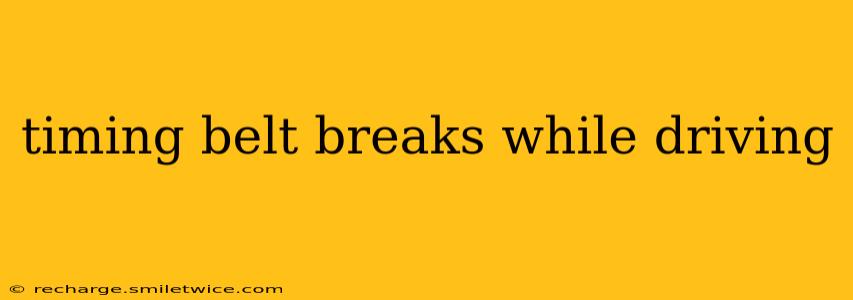A broken timing belt is a serious event that can leave you stranded and potentially cause significant engine damage. Understanding what happens when a timing belt breaks while driving, and how to react, is crucial for every driver. This comprehensive guide explores the immediate consequences, potential long-term damage, and the steps you should take if you face this unfortunate situation.
What Happens When a Timing Belt Breaks While Driving?
The timing belt is responsible for synchronizing the rotation of the crankshaft and camshaft in your engine. When it breaks, this synchronization is lost. The exact consequences depend on the type of engine (interference or non-interference) and the speed at which you're driving.
-
Interference Engines: In interference engines, the pistons and valves share the same space. A broken timing belt means the valves and pistons can collide, leading to severely bent or broken valves, damaged pistons, and potentially catastrophic engine failure. This is far more costly to repair than other types of damage.
-
Non-Interference Engines: In non-interference engines, the pistons and valves have enough clearance to avoid collision even if the timing is off. While a broken timing belt will immediately stop the engine, the damage is usually limited to the belt itself and perhaps some minor internal damage. Repair costs will be substantially lower compared to an interference engine.
Regardless of the engine type, the immediate result is usually a sudden loss of power. The engine will likely stall, and you'll lose the ability to steer using power steering (if hydraulically assisted). Braking might be affected as well, especially if your car uses power-assisted brakes.
What Are the Signs of a Failing Timing Belt?
Knowing the warning signs can help you avoid a complete break. Regular vehicle maintenance is key. However, some signs you can look for include:
-
Unusual Noises: A squealing, chirping, or slapping noise from the engine bay, particularly when starting the car, can signal wear and tear on the timing belt.
-
Visible Damage: During routine maintenance checks (or if you're particularly observant), you might notice cracks, fraying, or missing teeth on the timing belt.
-
Engine Misfires or Rough Idling: This indicates the timing is slightly off, potentially due to a worn or failing timing belt.
How Much Does Timing Belt Replacement Cost?
The cost of timing belt replacement varies greatly depending on the make and model of your vehicle, the labor rates in your area, and whether any additional parts need replacing (water pump, tensioners, etc.). It's best to obtain a quote from a trusted mechanic. Ignoring this crucial maintenance task could cost far more in the long run should the belt break.
What Should I Do if My Timing Belt Breaks While Driving?
Safety is paramount:
-
Maintain Control: Try to steer the vehicle to a safe location away from traffic. Your steering and braking might be affected.
-
Turn on Hazard Lights: Warn other drivers of your stalled vehicle.
-
Stay Calm: Panic can impair your judgment. Focus on bringing the car to a stop safely.
-
Call for Assistance: Contact roadside assistance or a tow truck. Never attempt to start the engine again after a timing belt break as it could cause further damage.
-
Have it Towed: Do not attempt to drive the vehicle. Towing is necessary to prevent additional damage.
Is it Safe to Drive After a Timing Belt Breaks?
No, it is generally not safe to drive after a timing belt breaks. Attempting to restart the engine risks further damage, potentially leading to a costly repair or even a need for engine replacement.
Can a Broken Timing Belt Be Repaired?
A broken timing belt is typically not repaired; it's replaced. The belt itself is relatively inexpensive, but the labor involved in replacing it, especially if other parts are damaged, can add significant cost to the repair.
How Often Should I Replace My Timing Belt?
The recommended replacement interval for timing belts varies considerably depending on the vehicle's make, model, and engine. Consult your owner's manual for the manufacturer's suggested replacement schedule. Ignoring the recommended interval significantly increases the risk of a catastrophic failure.
This comprehensive guide provides a detailed understanding of timing belt failure. Remember, preventative maintenance and regular inspections are crucial in avoiding this costly and potentially dangerous situation. Always consult your vehicle's owner's manual for specific maintenance recommendations.
